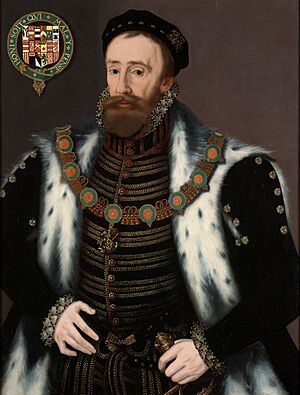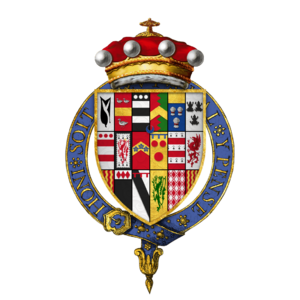Edward Hastings, 1st Baron Hastings of Loughborough facts for kids
Edward Hastings, 1st Baron Hastings of Loughborough (born around 1521 in Loughborough, Leicestershire – died 1572) was an important English nobleman. He was the fourth son of George Hastings, 1st Earl of Huntingdon. Edward Hastings married Joane Harrington around 1544.
Contents
Edward Hastings' Early Career
Edward Hastings began his public life as a representative for his local area.
Serving in Parliament
From 1545 to 1547, he was a Member of Parliament (MP) for Leicester. An MP is someone elected to speak for their town or region in the country's government.
High Sheriff and More Parliament Roles
In 1550, Edward Hastings became the High Sheriff of Leicestershire and High Sheriff of Warwickshire. A High Sheriff was a royal official responsible for law and order in a county. He also served as an MP for Leicestershire from 1547 to 1553.
Fighting for England
Edward Hastings fought alongside his brother against the French. These battles took place between the French towns of Boulogne and Calais.
Supporting Queen Mary I
Edward Hastings played a key role when Mary I became queen.
Loyalty to the Crown
In July 1553, when Queen Mary I took the throne, Edward Hastings showed his loyalty. He had been given permission by a relative, the Duke of Northumberland, to gather 4,000 soldiers. These soldiers were meant to support Lady Jane Grey. However, Edward Hastings used this power to instead support Mary I.
Rewards for Loyalty
Queen Mary I rewarded Edward Hastings for his support. He was given the job of Receiver of the honour of Leicester. This meant he managed some lands belonging to the Duchy of Lancaster. He also became a Privy Councillor, which meant he advised the monarch. Soon after, he was made Master of the Horse, a very important position in the royal household. He continued his political career as an MP for Middlesex from 1553 to 1555.
Royal Recognition
King Philip of Spain, who was married to Queen Mary I, thought highly of Edward Hastings. The King gave him a pension of 500 crowns of English money. Edward Hastings also traveled with Lord Paget to invite Cardinal Pole to England. In 1555, he was chosen as a Knight Companion of the Order of the Garter. This is a very special award given by the monarch.
Becoming a Baron
On December 25, 1557, he became the Lord Chamberlain of the Household. This was another high-ranking position in the royal court. Then, on January 19, 1558, he was given the title of Baron Hastings of Loughborough. This made him a nobleman.
Later Life and Legacy
After Queen Mary I died, Edward Hastings stepped away from public life.
Retirement and Philanthropy
He became quite sad after Mary's death. In 1561, he was briefly held for attending a religious service that was not allowed at the time. However, he was released after he promised loyalty to the Queen. In April 1564, he founded a hospital in Stoke Poges, Buckinghamshire. This shows his care for others.
Death and Burial
Edward Hastings lived at the Manor House in Loughborough. He passed away in March 1572 at Stoke Poges. In his will, he mentioned his son, Edward. He left his son the Manor of Michelcreche in Somerset when he became an adult. He also gave his manor of Bosworth to his nephew, Henry Hastings, 3rd Earl of Huntingdon.
Edward Hastings was buried in a special chapel he had built. This chapel is part of the Church of St Giles, Stoke Poges.



